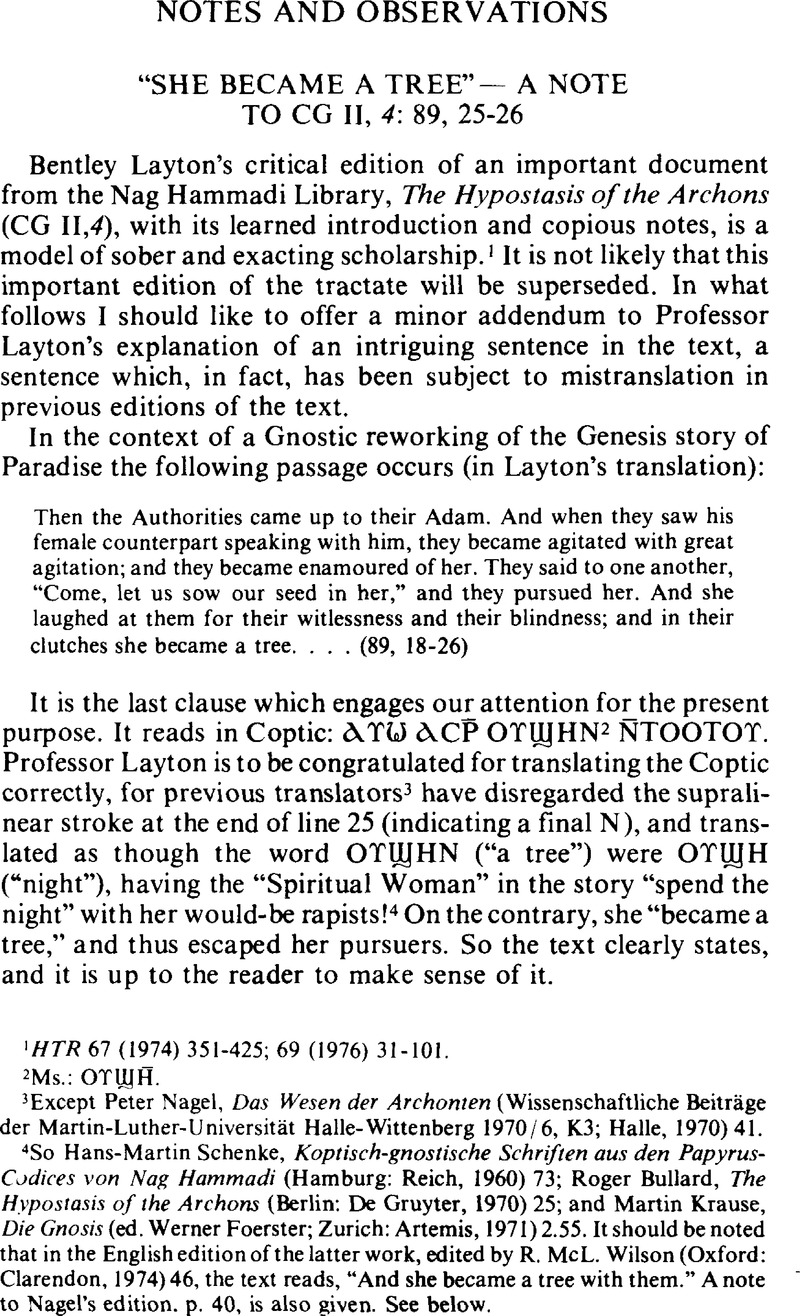Published online by Cambridge University Press: 10 June 2011

1 HTR 67 (1974) 351–425; 69 (1976) 31–101.
2 Ms.: ![]() .
.
3 Nagel, Except Peter, Das Wesen der Archonten (Wissenschaftliche Beiträge der Martin-Luther-Universität Halle-Wittenberg 1970/6, K3; Halle, 1970) 41.Google Scholar
4 So Schenke, Hans-Martin, Koptisch-gnostische Schriften aus den Papyrus-Codices von Nag Hammadi (Hamburg: Reich, 1960) 73Google Scholar; Bullardm, Roger, The Hypostasis of the Archons (Berlin: De Gruyter, 1970) 25Google Scholar; and Krause, Martin, Die Gnosis (ed. Foerster, Werner; Zurich: Artemis, 1971) 2.Google Scholar 55. It should be noted that in the English edition of the latter work, edited by Wilson, R. McL. (Oxford: Clarendon, 1974) 46Google Scholar, the text reads, “And she became a tree with them.” A note she became a tree with them.” A note to Nagel's edition, p. 40, is also given. See below.
5 See his explanatory note 60, HTR 69 (1976) 57.Google Scholar I am grateful to Professor Layton for giving me a prepublication copy of Part II of his edition.
6 See the color photo in Grant, Michael, Eros in Pompeii (New York: William Morrow, 1975) 166Google Scholar, “Pan and Hamadryad.” The caption reads, “From the Museum of Noja,” but this is doubtless a misprint.
7 Cf. “Hamadryaden,” PW 7:2, 2287–92, and literature cited. Cf. also Daremberg-Saglio, “Nymphae,” Dictionnaire des antiquités grecques et romains 4:1. 124–28.
8 Cf. Michael Grant, ibid. One might also compare the story of Pitys, who escaped the lustful advances of Pan by turning into a pine tree: Nonnus Dionysiaca 2. 108; cf. 42.259. The same passages in Nonnus refer also to Daphne, who escaped the wooing of Apollo by turning into a laurel tree. Nagel refers to Daphne in his note to Hyp. Arch. 137 [ =89],25; see Das Wesen der Archonten, 40, where he refers to Lucian Verae historiae 1.8. For Daphne, see also Ovid Metamorphoses 1.452. It should be added that the reference to Propertius in Rouse's translation of Nonnus (LCL), in his note to Dionysiaca 2.108 on Pitys, is fictitious; the story of Pitys does not occur in Propertius. Pitys is mentioned in Longus 2.7 and 39, and Lucian Dialogi mortuorum 22.4.
9 In the parallel text in the treatise On the Origin of the World (CG II, 5), “Eve” escapes the lustful pursuit of the “Authorities” by entering the Tree of Knowledge and remaining there; to the Authorities it appears as though she had become a tree. See CG II, 116 [ = Böhlig ed. 164], 28-32. Cf. the Apocryphon of John, BG 57, 8ff.: the Tree of the Knowledge of Good and Evil is the “Thought of Light” (equated with “Life,” the “helper” sent to Adam at 53, 8-9). This “Thought of Light” the “Darkness” “pursued,” but “could not grasp,” for she is “unattainable” (BG 59, 9-12).